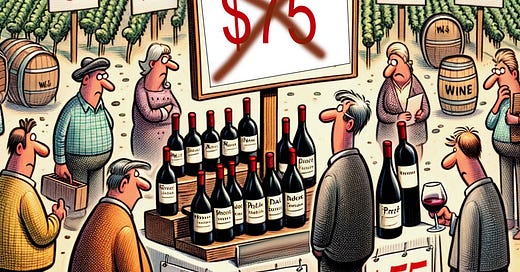Editor’s note: We are delighted to welcome Dan Berger as our newest contributor at Napa Valley Features. Dan's extensive career in journalism, spanning nearly half a century, brings a depth of expertise and a unique perspective to our publication. Known for his rigorous approach, deadpan humor and healthy skepticism, Dan’s writing is marked by thorough research and a distinctive, engaging style. His zeal for wine, writing and challenging norms has an unparalleled vibrancy.
Dan is a respected figure in the wine industry, known for his commitment to truth and quality in his articles. His work stands out for its originality, often intertwining diverse elements and adding an entertaining twist to his insightful analyses.
His addition to our team promises to bring empowering insights and enriching content to our readers, setting a high standard for journalism at Napa Valley Features.
NAPA VALLEY, Calif. — It isn’t quite the same as negotiating the price of a house or an automobile, but savvy California wine consumers are almost ready to begin haggling for some of the priciest wines that are being produced today. The major reason for this is that the entire California wine industry is facing some of the worst economic times it has ever faced — even though some of the highest-image, iconic examples continue to sell for ludicrously high prices. Just below the top tier, however, chaos reigns.
There are several seemingly unconnected reasons for this, and winery owners know all too well that things can only get worse before they improve. At the moment, however, cash flow has become a trickle, everyone is facing serious consequences from the various fallouts and the only winners in all of this are extremely aware wine buyers seeking bargains.
A huge reason for the problems facing the industry are due directly to the cataclysmic effects of COVID-19, which led to the shutting down of retail and restaurant operations around the world. That forced wineries to establish new strategies for wine sales. Many of the new tactics worked brilliantly, but as consumers soon understood how the new game was played, many of them rebelled.
COVID-19 did far more than simply change the rules of the game. Restaurants and retailers who resumed operations as the pandemic subsided realized that the number of wine offerings they were carrying in inventory represented an albatross of significant financial weight.
As inventories began to rebound, most retail and restaurant operations were still saddled with some older stock, some of which had not improved. To sell some of the older bottles, the trade had to discount their existing inventories. In some cases, those discounts spoiled patrons who believed that pricing had been too high all along. This was particularly evident in restaurants, where margins had crept up and up over the years, separating standard wines from the ever-expanding retail discount warehouses, which were booming.
Another thing that COVID-19 did was to accelerate the creativity in wine sales by large discounters and warehouse operations, many of whom had never really tested shipping wine across state lines to any great degree. But with patrons staying at home, retail wine-store shipping became a way of life. And consumers began to accept shipping charges as a necessary burden that benefited them. No longer necessary were long trips to brick-and-mortar stores. It meant that buyers didn’t have to pay for gasoline, bridge and road tolls, parking or any of the other assorted hassles involved in going to wine stores. Direct-to-consumer sales encouraged retailers to put their entire inventories into online databases, allowing consumers to shop conveniently from home.
Likewise, wineries developed DTC platforms that were complete with discounts for certain buyers such as club members, loyal customers and new sign-ups. So, although winery revenues declined from the loss of festive events like weddings that once were routinely held at wineries, what increased were direct-to-consumer sales, which always produces greater revenue than selling through an expensive three-tier system.
However, some wines began to hit a brick wall as the pandemic subsided. Take the case of the pricing of premium quality wines such as pinot noir from the best regions in California.
Before the pandemic, top-quality pinot noir from places like Russian River Valley, Petaluma Gap and Santa Lucia Highlands were selling for roughly $45 to $50 per bottle. I’d guess that probably about 30 or 40 such producers were selling pinot at that price point in 2010.
But dozens of winemakers and owners knew the public was extremely excited by pinot noir. As a result, vineyard lands in cooler areas were considered prized property, not only because of impending problems associated with global climate change but also because wineries believed they could plant pinot noir, which did not need as much time from harvest to market as did many cabernets.
The importance of pinot noir to the California retail and restaurant wine business became obvious on Aug. 3, 2015, when Constellation Brands, a New York-based wine behemoth, acquired the Meiomi brand from the Wagner family for $315 million – even though no vineyards or winery were connected with the sale. Although Constellation later would add other grape varieties to the brand, the sale was primarily based on the fact that Meiomi had developed quite a reputation for selling slightly sweet pinot noirs. Wine reviewers didn’t consider it to be a particularly excellent wine, but it sold extremely well.
Within two years, pinot noir was being produced by literally dozens of people who were charging between $30 and $90 per bottle. And although quality frequently was mediocre, the public responded enthusiastically by buying many of these wines. In the last two years, however, the game changed again as wineries that made truly excellent pinot noir began to increase their prices to $75 – and found resistance.
A few weeks ago I was speaking with a winery owner from the Russian River Valley. His pinot noir was intended to sell for $75. But he shook his head slowly and said, “I doubt I can get $55 for it today. People just aren’t paying that kind of money for pinot.” And a sales associate at a nearby Russian River Valley winery said, “We’re still selling our (reserve pinot) for $75, but we almost never sell more than a bottle or two at a time. We used to sell a case now and then. Not anymore.”
It's almost exactly the same story when it comes to cabernet. Prices for the highest quality cabernets from Napa Valley never really declined precipitously, but anecdotally I’ve heard that dozens of Napa cabernets that used to sell for well over $100 now are being discounted quietly, mainly because there are too many expensive wines that all seem to be well beyond what consumers are willing to pay.
Even some overseas glitches became problematic for the California wine industry. Take, for example, the trade war between Australia and China. When tariff increases on Australian wines were imposed by the Chinese in 2021, it cut heavily into Australian wine sales to China. I immediately thought that fracas would lead to Australians seeing the U.S. market as a solution. Many Australian wine companies did decide that was a good solution and made plans to market their wines here.
However, problems arose. Shipping such long distances became prohibitively expensive, and supply-chain delays made things worse. So Aussie wines never really developed a major presence here. As shipping began to return to normal in the last year, Aussie wines have now become more plentiful in the United States, similar to how they had been just before 2000. Today the category represents a looming threat to California wine sales, notably because prices are extremely fair, based on the weakness of the Australian dollar (66 U.S. cents).
Consumers who feel that many California wines are overpriced may be right, but if you are standing in a Rutherford tasting room with all the trappings of history, nostalgia and the promise of ethereal experiences, many buyers seem almost giddy about paying full price. Weeks later when the credit card bill arrives, however, some buyers may wonder where their common sense journeyed in that moment.
If today's story captured your interest, explore these related articles:
Dan Berger has been writing about wine since 1975.








All very astute observations, for sure. To add to Dan's commentary, he did not get into the quagmire that is three-tier sales and marketing which, in and of itself, is a herculean task to just get into let alone get traction let alone make a profit. DtC used to be a great way to counter balance the ever-increasingly challenging 3-tier system but as Dan has pointed out, even that channel is showing major signs of distress.